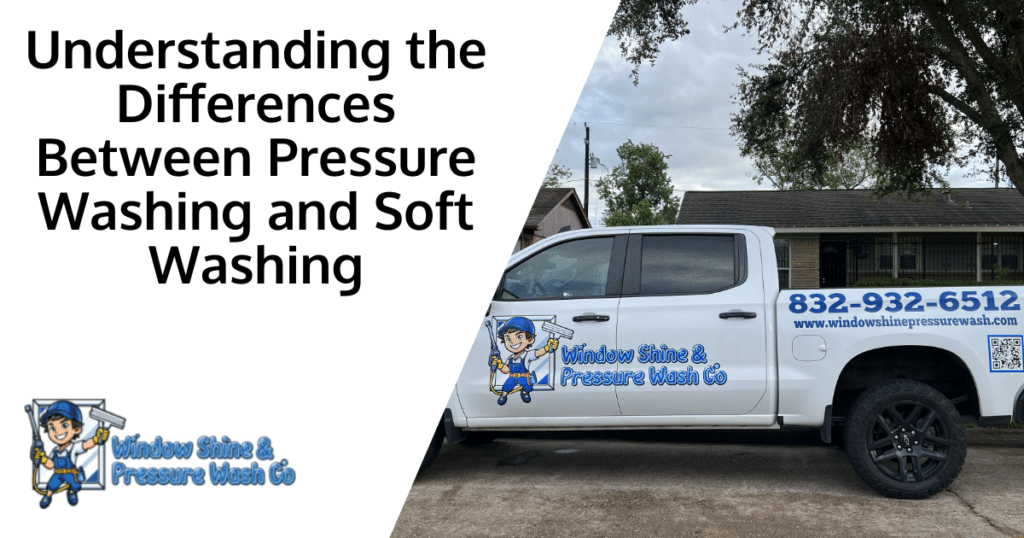Effective Washing
Pressure washing and soft washing are popular strategies for handling a variety of cleaning tasks. To begin a discussion about these two tactics, it’s first important to grasp what each of them encompasses.
What is Pressure Washing?
Pressure washing is a cleaning method that uses a powerful, high-pressure water jet to remove grime, dust, loose paint, mold, and other dirt from surfaces. The high-pressure water stream is put through a specialized nozzle, causing the water to be propelled at a force sufficient enough to clean even most stubborn of dirt. It operates on the simple principle of force exerted on a surface area—the higher the pressure, the more potent the cleaning power, making it perfect for tougher jobs.
Applications of Pressure Washing
Pressure washing’s high pressures makes it highly versatile, making it suitable for various surfaces such as concrete driveways, wooden decks, vinyl sidings, and even certain types of stone patios. Its ability to adjust pressure levels allows it to be used with consideration to the surface material’s durability.
Common Issues Addressed by Pressure Washing
Beyond just surface debris and regular dirt, pressure washing is also effective against pollutants like mold, mildew, and unsightly stains that other cleaning methods may struggle against. This makes it a popular option for maintaining residential and commercial properties.
- Materials such as concrete, stone, and wood are preferred surfaces for pressure washing because of their robustness and resiliency.
- To handle stubborn stains, pressure washing can be supplemented with a special cleaning solution that is made to work in conjunction with water and pressure.
- Delicate surfaces, like glass or lacquered wood, would be at risk of damage under high pressure and thus are typically avoided for this cleaning method.
Advantages and Limitations of Pressure Washing
Pressure washing offers a swift and efficient means of maintaining the cleanliness and aesthetics of your space. It can tackle difficult stains and pollutants without the need for intense manual labor. However, as earlier mentioned, it’s forceful technique could prove too harsh for certain materials and surfaces.
The Essentials of Soft Washing
What is Soft Washing?
Soft washing differs from pressure washing in terms of its pressure levels and method of cleaning. Instead of relying on high-pressure water to clean, soft washing uses a mixture of low-pressure water and a specialized cleaning solution. This solution, while mild on surfaces, eliminates dirt, mildew, algae, fungus, and other contamination on a microbial level.
Applications of Soft Washing
The gentler approach of soft washing makes it perfect for delicate surfaces that can be damaged by high-pressure washing. These include but are not limited to roofs, paintwork, and sensitive materials.
Unique Cleaning Issues Addressed by Soft Washing
Soft washing, because of its chemical solution, is particularly effective against organic growths such as algae and mildew. These organisms can be forcefully removed by pressure washing, but without an organic solution, they might regrow.
- Soft washing is preferred for surfaces that are delicate, prone to damage, or contain organic growth.
- The proprietary blend of detergents in soft washing helps to break the hold of organic contaminants on the surface, ensuring a thorough clean.
- Surfaces made of natural elements—like certain types of stone—may react negatively with certain chemicals in the cleaning solution used in soft washing and needs to be considered while cleaning.
Pros and Cons of Soft Washing
Soft washing upholds the integrity of delicate surfaces while providing a comprehensive clean, particularly against organic growth. On the flip side, preparation and cleaning with soft washing could be more time-consuming than pressure washing due to the need for exact dilutions and application techniques
Comparing Pressure Washing and Soft Washing
Key Differences Between the Two Methods
In pressure washing, the cleaning action comes from the force of the water, while in soft washing, the cleaning solution does the heavy lifting. They serve different purposes based on the task and surface and require different preparations and techniques likewise.
Choosing the Right Method for Your Needs
The choice between pressure washing and soft washing depends upon the nature of surface and type of contaminant to be cleaned. A cleaning professional can perform a surface analysis to decide the suitable method, after considering the durability and the nature of stains present.
Emerging Trends in Surface Cleaning
In the cleaning industry, there is a growing move towards eco-friendly practices and the usage of biodegradable cleaning solutions. Similarly, improvements in machinery, such as the penetration of automated and programmable pressure and soft washers, are paving the way for more efficient and precise cleaning.
Best Practices and Tips for Effective Cleaning
Key Factors to Ensure Effective Washing
Whether it is pressure washing or soft washing, factors like proper training, adhering to safety protocols, and the correct choice of cleaning solutions greatly impact the cleaning quality. Similarly, regular maintenance of the cleaning equipment and timely replacement of worn-out parts ensure consistency in cleaning performance.

